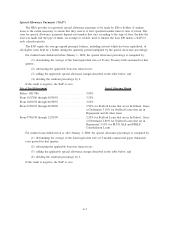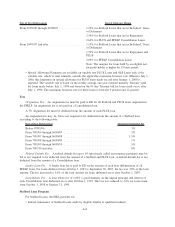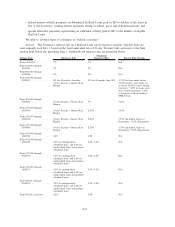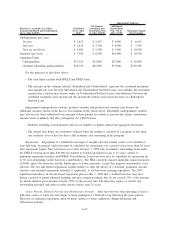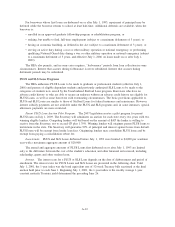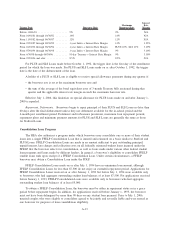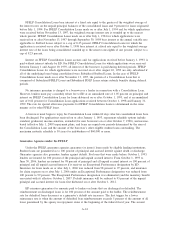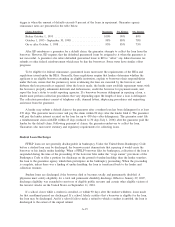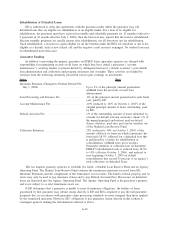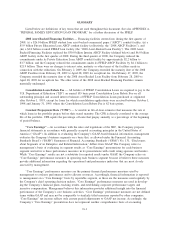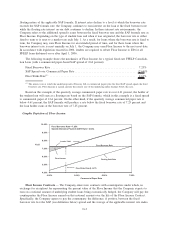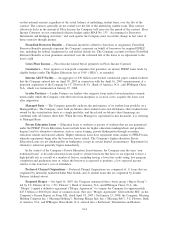Sallie Mae 2008 Annual Report Download - page 235
Download and view the complete annual report
Please find page 235 of the 2008 Sallie Mae annual report below. You can navigate through the pages in the report by either clicking on the pages listed below, or by using the keyword search tool below to find specific information within the annual report.GLOSSARY
Listed below are definitions of key terms that are used throughout this document. See also APPENDIX A,
“FEDERAL FAMILY EDUCATION LOAN PROGRAM,” for a further discussion of the FFELP.
2008 Asset-Backed Financing Facilities — Financing facilities entered into during the first quarter of
2008: (i) a $26.0 billion FFELP student loan asset-backed commercial paper (“ABCP”) conduit facility; (ii) a
$5.9 billion Private Education Loan ABCP conduit facility (collectively, the “2008 ABCP Facilities”); and
(iii) a $2.0 billion secured FFELP loan facility (the “2008 Asset-Backed Loan Facility”). The 2008 Asset-
Backed Financing Facilities replaced the $30.0 billion Interim ABCP Facility (defined below) and $6.0 billion
ABCP facility in the first quarter of 2008. During the third quarter of 2008, the Company reduced the
commitments under its Private Education Loan ABCP conduit facility by approximately $2.2 billion to
$3.7 billion; and the Company reduced the commitments under its FFELP ABCP Facilities by $4.1 billion to
$21.9 billion. There were no changes to interest rates, maturity or other terms of the facilities made in
connection with the reductions. On February 2, 2009, the Company extended the maturity date of the 2008
ABCP Facilities from February 28, 2009 to April 28, 2009 for an upfront fee. On February 27, 2009, the
Company extended the maturity date of the 2008 Asset-Backed Loan Facility from February 28, 2009 to
April 28, 2009 for an upfront fee. The other terms of the 2008 Asset-Backed Financing Facilities remain
materially unchanged.
Consolidation Loan Rebate Fee — All holders of FFELP Consolidation Loans are required to pay to the
U.S. Department of Education (“ED”) an annual 105 basis point Consolidation Loan Rebate Fee on all
outstanding principal and accrued interest balances of FFELP Consolidation Loans purchased or originated
after October 1, 1993, except for loans for which consolidation applications were received between October 1,
1998 and January 31, 1999, where the Consolidation Loan Rebate Fee is 62 basis points.
Constant Prepayment Rate (“CPR”) — A variable in life-of-loan estimates that measures the rate at
which loans in the portfolio prepay before their stated maturity. The CPR is directly correlated to the average
life of the portfolio. CPR equals the percentage of loans that prepay annually as a percentage of the beginning
of period balance.
“Core Earnings” — In accordance with the rules and regulations of the SEC, the Company prepares
financial statements in accordance with generally accepted accounting principles in the United States of
America (“GAAP”). In addition to evaluating the Company’s GAAP-based financial information, management
evaluates the Company’s business segments on a basis that, as allowed under the Financial Accounting
Standards Board’s (“FASB”) Statement of Financial Accounting Standards (“SFAS”) No. 131, “Disclosures
about Segments of an Enterprise and Related Information,” differs from GAAP. The Company refers to
management’s basis of evaluating its segment results as “Core Earnings” presentations for each business
segment and refers to these performance measures in its presentations with credit rating agencies and lenders.
While “Core Earnings” results are not a substitute for reported results under GAAP, the Company relies on
“Core Earnings” performance measures in operating each business segment because it believes these measures
provide additional information regarding the operational and performance indicators that are most closely
assessed by management.
“Core Earnings” performance measures are the primary financial performance measures used by
management to evaluate performance and to allocate resources. Accordingly, financial information is reported
to management on a “Core Earnings” basis by reportable segment, as these are the measures used regularly by
the Company’s chief operating decision makers. “Core Earnings” performance measures are used in develop-
ing the Company’s financial plans, tracking results, and establishing corporate performance targets and
incentive compensation. Management believes this information provides additional insight into the financial
performance of the Company’s core business activities. “Core Earnings” performance measures are not defined
terms within GAAP and may not be comparable to similarly titled measures reported by other companies.
“Core Earnings” net income reflects only current period adjustments to GAAP net income. Accordingly, the
Company’s “Core Earnings” presentation does not represent another comprehensive basis of accounting.
G-1


